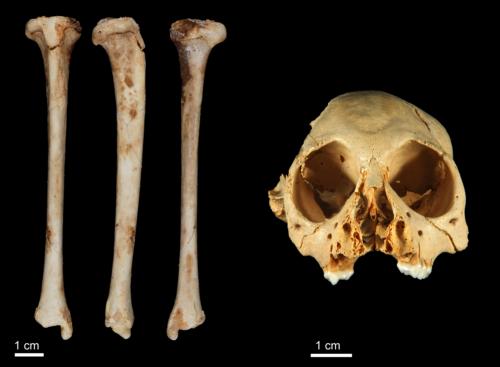科學家在加勒比海伊斯帕尼奧拉島水底洞穴,發現130萬年前的猴子骨骸化石。科學家懷疑,該種猴子的滅絕可能與歐洲人登陸開墾有關。
 |
| 滅絕猴種(Antillothrix bernensis)的脛骨化石。攝影:Siobhan Cooke;來源:Grand Valley State University。 |
伊斯帕尼奧拉猴小如貓 疑因人類開墾滅絕
洞穴潛水員在多明尼加共和國最東邊省份的Padre Nuestro洞穴,發現滅絕獼猴伊斯帕尼奧拉猴(Antillothrix bernensis)的脛骨化石。
「伊斯帕尼奧拉猴是伊斯帕尼奧拉島兩種已經滅絕的靈長類之一。過去發現的靈長類化石年份都在1萬年內。這次新化石的形態跟過去的發現相符,但是年份卻在130萬年前。」Tallman說。
伊斯帕尼奧拉猴和小貓差不多大小,住在樹上,以水果和樹葉為食。一位參與探索計畫的科學家認為,人類佔領伊斯帕尼奧拉島時,這些小猴子很可能還在島上。
過去認為,伊斯帕尼奧拉猴滅絕於16世紀。詳細滅絕時間和原因不明,但科學家認為和1492年哥倫布發現伊斯帕尼奧拉島後,歐洲人登陸開墾有關。
Tallman表示,從19世紀達爾文的年代起,科學家就對加勒比海地區靈長類化石的年齡感到困惑。「這些靈長類,起碼牠們的脛骨部分,型態相當穩定。很明顯地,牠們很有彈性地適應島上環境,以致於型態可以穩定不變長達1百萬年。人類首次開墾大安得列斯島時,牠們很可能還在島上。」
加勒比海島上滅絕物種多 化石鑑定不易
發現化石的潛水員都是多明尼加洞穴協會的創始成員。他們發現的骨骸化石位於島的南岸,距離多明尼加首都聖多明哥約70英哩、112公里。化石的年份鑑定在密西根大谷州立大學進行。
「加勒比海島嶼有很多樣的滅絕動物群,但是鑑定該化石的年代並不容易。」大谷州立大學生醫科學助理教授Melissa Tallman說。Tallman表示,根據骨骼化石的結構和型態,也就是形態學,可以辨識出該化石屬於Antillothrix bernensis,而從化石發現處的岩石可以辨識出該動物所生活的時代。
此次發現的伊斯帕尼奧拉猴化石嵌在石灰岩中,研究人員以鈾系法鑑定該石灰岩的年份。「石灰岩形成時,鈾進入石灰岩中,經天然輻射過程衰變形成釷和鉛。科學家以鈾衰變速率以及今日岩石的鈾、釷和鉛含量計算出岩石的年齡。」Tallman解釋道。
研究全文發表於《人類演化期刊》。
The fossilized bone of a monkey that lived 1.3 million years ago has been found in an underwater cave on the Caribbean island of Hipaniola.
 |
| 加勒比海的伊斯帕尼奧拉島水底洞穴。攝影:Laurent Benoit;來源:Grand Valley State University。 |
A team of cave divers recovered the fossil shin bone belonging to an extinct species of monkey, Antillothrix bernensis, from Padre Nuestro cave in the easternmost province of the Dominican Republic.
Cave divers Cristian Pittaro of Argentina; Phillip Lehman of the UK; Dave Pratt of the United States; and Victoria Alexandrova of Russia, all founding members of the Dominican Speleological Society, discovered the fossilized bone in the dive cave on the island’s southern shore, about 70 miles, 112 km from the Dominican capital, Santo Domingo.
The Hispaniola monkey, Antillothrix bernensis, is thought to have gone extinct around the 16th century.
The exact timing and cause of the extinction are unclear, but scientists believe it is related to the settlement of Hispaniola by Europeans in 1492 after discovery of the island by Christopher Columbus.
The species was roughly the size of a small cat and lived in trees, eating fruits and leaves. These small monkeys were likely still on Hispaniola when humans first colonized the island, says a scientist involved in the discovery.
Dating of the fossilized bone was conducted at Grand Valley State University in Allendale, Michigan.
“We know that there is a diverse extinct fauna on the Caribbean Islands, but dating the material has been difficult,” said Melissa Tallman, assistant professor of biomedical sciences at Grand Valley.
Tallman says the structure and form of the bone, known as its morphology, identifies the monkey as Antillothrix bernensis, and dating of the rock where it was found embedded identifies how long ago it lived.
“Antillothrix bernensis is one of two species of extinct primate on Hispaniola. Previously discovered primate material has all been dated to within the last 10,000 years,” said Tallman. “This new material is morphologically consistent with the previously collected material, but is dated to 1.3 million years ago.”
The fossil was embedded in a limestone rock that was dated using the Uranium-series technique.
“When the limestone rocks are formed, uranium gets trapped in them and decays by natural radioactive processes to form thorium and lead,” Tallman explained. “Scientists know the rate at which uranium decays and by measuring the amount of uranium, thorium and lead present in the rocks today, one can calculate the age of the rocks.”
Tallman said since the days of Charles Darwin in the 19th century scientists have been puzzled over the age of primate fossils from this region.
“Many times when a long-lived species is discovered, there is a shift in its morphology over time,” Tallman said. “For these primates, at least in the tibia, they remained remarkably stable morphologically. They obviously adapted to their island environment in such a way that was flexible enough that it allowed them to persist for more than one million years. They were likely still around when humans first colonized the Greater Antillean Islands.”
The full study is published in the “Journal of Human Evolution.”
※ 全文及圖片詳見:ENS






